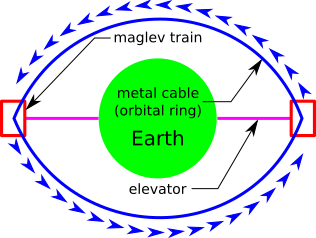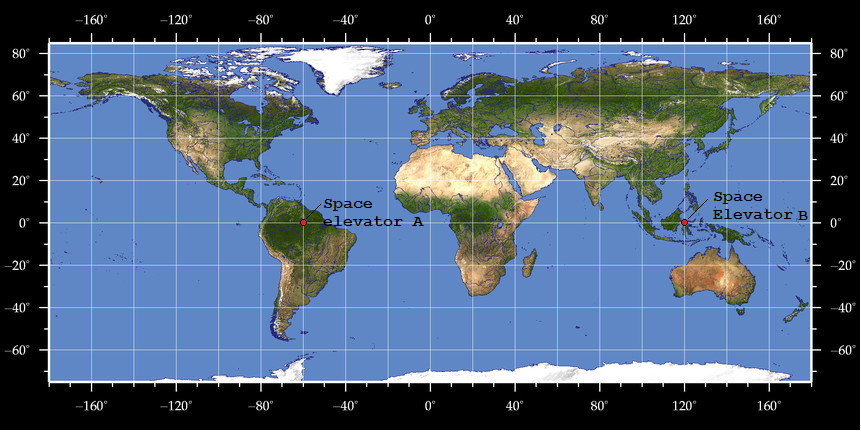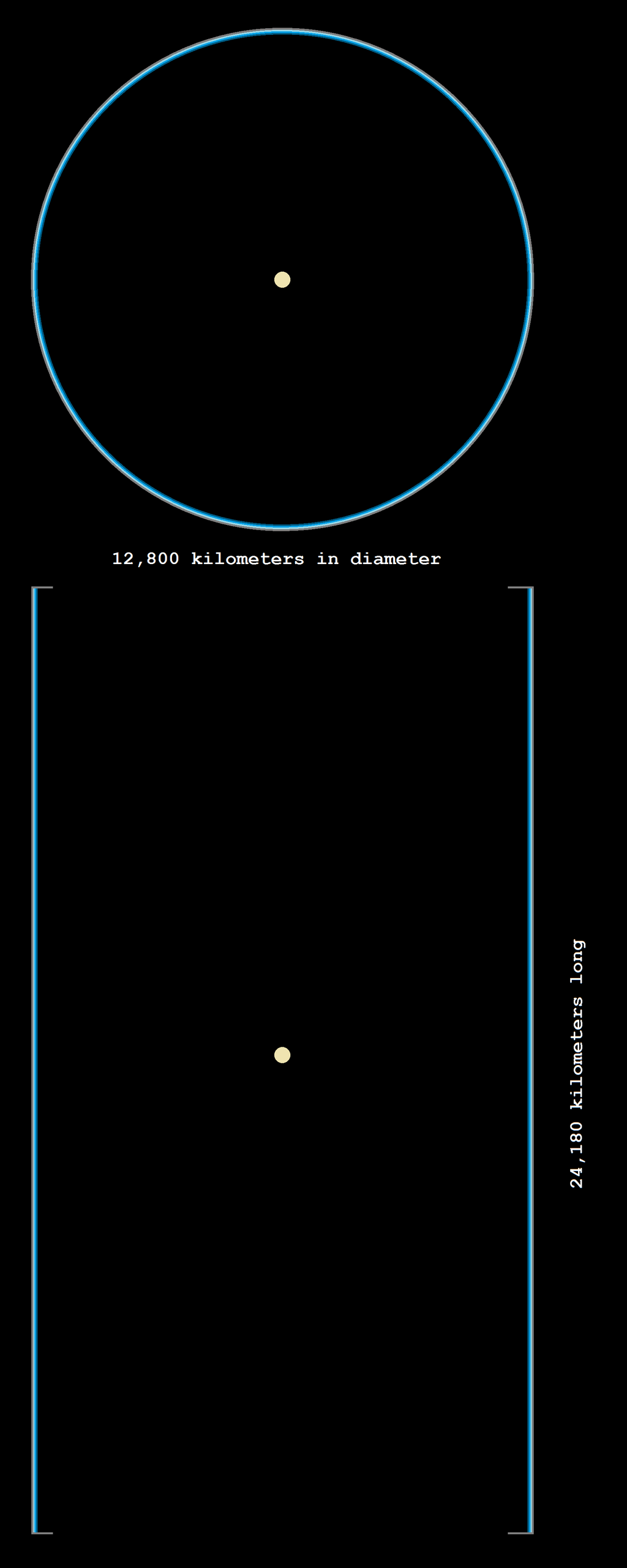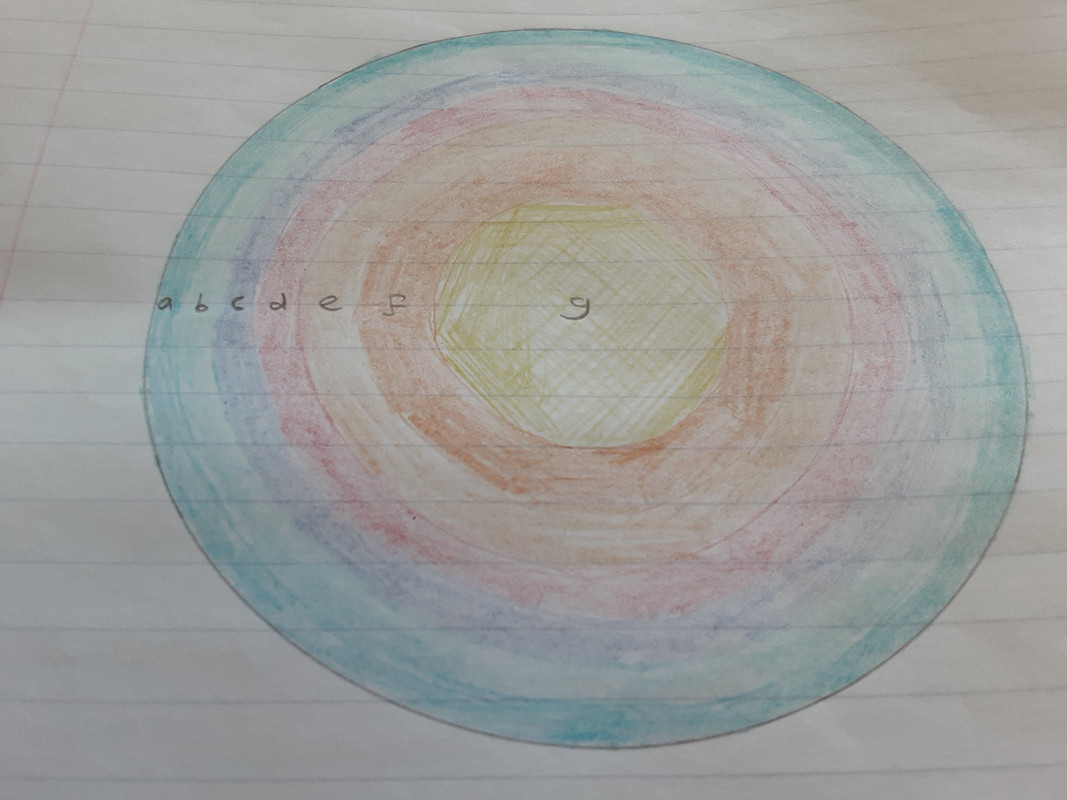New Mars Forums
You are not logged in.
- Topics: Active | Unanswered
Announcement
#26 2016-10-20 02:01:16
- karov
- Member
- From: Bulgaria
- Registered: 2004-06-03
- Posts: 953
Re: Artificial Suns and how to make them
Tom,
btw, carbon incandescent filaments charged as elecrodynamic tethers from planetary / brown dwarf dynamos fit quite nicely with optimization of the emitted light if sheath-ed with rotating colony.
Like.: http://www.iase.cc/openair.htm - aka "Bishop rings" which seamlessly may grow into macaroni hab of arbitrary length.
Using orbital rings the linear electric 'lampage' could be provided with current not from deorbiting mass but from despinning the big central body.
like this.:
[image]https://upload.wikimedia.org/wikipedia/ … ng.svg.png[/image]
where the red rectangles are the habitats.
At the lowest points the orbital rings could in fact dip into the atmosphere and to exchange mass - to excavate up and to download.
The carbon illumination filament centered as a colony's axis would be the stator and the orbital ring the rotor of a massive electric generator converting the planetary spin into helluva electric power...
Offline
Like button can go here
#27 2016-10-20 09:05:49
- Tom Kalbfus
- Banned
- Registered: 2006-08-16
- Posts: 4,401
Re: Artificial Suns and how to make them

The trick is how do you build it? The International Space Station orbits at 400 kilometers above the Earth's surface. Not the idea appears to be to build two space elevators on opposite ends of the Earth. Preferably over the equator.
Here are two locations at opposite ends of the Earth where such elevators may be located. coincidently, its hard to find two such areas along the equator that are also on dry land, there are probably the best locations for these elevators. Now if the elevators are to be 400 kilometers high, we need a belt that is in orbit at an altitude that is 400 km above the equator, that also means it has a radius of 400 km + 6400 km = 6800 km, the circumference of the belt would thus be 2 * 6800 km * Pi = 42,725.66 km. If we assign a mass of 10 kg per meter then 1 kilometer would have a mass of 10 metric tons, the entire belt would thus have a mass of 427,256.6 metric tons. this belt would support two space elevators at opposite ends of the Earth. I suppose this would be useful for Venus and other bodies that don't rotate much. You could do this with Saturn, it would be a much bigger belt of course, and there is ring material to work with Two tethers can dip into Saturn's atmosphere One can dangle a colony from each of these tethers. You could probably suck in hydrogen and use it to power your fusion reactors.
Offline
Like button can go here
#28 2016-10-20 09:14:18
- Tom Kalbfus
- Banned
- Registered: 2006-08-16
- Posts: 4,401
Re: Artificial Suns and how to make them
Yeah.
Like massive maglev bearing.
But I have no idea how to calculate the structure: how thick/massive the non-moving 'topobase' to be etc.
What are the limits?
What if you used tungsten? That is a very dense material, and since weight is not a consideration, I wonder how strong tungsten cables would be? The density of Tungsten is
19.25 g/cm3 or 19.25 tons per cubic meter, it is a very dense material and very tough, We can excavate tunnels within the hull of the cylinder and form ribs that are out of the way. One can have exits and airlocks between the ribs if one wants direct access to space through the floor.
Last edited by Tom Kalbfus (2016-10-20 09:15:27)
Offline
Like button can go here
#29 2021-07-24 08:16:48
- tahanson43206
- Moderator
- Registered: 2018-04-27
- Posts: 23,375
Re: Artificial Suns and how to make them
For SpaceNut .... it is time for this older topic to return to view...
While the topic itself appears (my first impression) to be about solar objects (like our Sun) I am hoping to restart the topic with something a bit more practical.
Years ago, after World War II, there were a number of war surplus search lights available, and I remember then painting the sky for festivals to the South and North where small cities were located in the rural region where our family lived. That was when I attended a one room school, to put it into context.
Those search lights were designed to produce light from a hefty electric arc. Some movie projectors ran on the same technology, but I've only read about that. I never saw one in operation.
With Calliban's initiative to design a hefty 1 Mw fission reactor that can be deployed for 10 years at a time, we can see possibilities for Mars habitation opening that might not have been possible with less robust power sources.
It is in this context that I invite (hopefully learned) discussion of the specific requirements for an "artificial sun" lighting system for large cavernous spaces on Mars. The spectrum of the Sun is the one we (humans and animals and plants) have "grown up" with, so I would expect an artificial sun to reproduce the beneficial spectra, while eliminating (if possible) the frequencies that serve no useful purpose, such as Ultra Violet ones.
This subtopic is introduced within the larger topic of Terraformation.
This is ** not ** Terraformation ... this would be Terrasimulation, accomplished on the scale of habitats, and not an entire planet.
(th)
Offline
Like button can go here
#30 2021-07-24 10:13:34
- SpaceNut
- Administrator
- From: New Hampshire
- Registered: 2004-07-22
- Posts: 29,861
Re: Artificial Suns and how to make them
For a realistic artificial sun to be created in the openness of space one must look at the movement and buildup of the elements needed to create the mass required to start and sustain fusion. Then what is there to continue to feed it around that new life we have spawned.
Offline
Like button can go here
#31 2021-07-24 10:20:55
- tahanson43206
- Moderator
- Registered: 2018-04-27
- Posts: 23,375
Re: Artificial Suns and how to make them
For SpaceNut ... I take your hint to not try to move the topic away from the original intent ...
I'll start a new topic dedicated to creating artificial sunlight for habitats (on Earth or off).
(th)
Offline
Like button can go here
#32 2024-06-10 05:33:31
- Calliban
- Member
- From: Northern England, UK
- Registered: 2019-08-18
- Posts: 4,266
Re: Artificial Suns and how to make them
I feel it is time to resurect this old topic, originally raised by Tom Kalbfus.
This idea is for an artificial fusion based star, which would provide energy for humans living in the outer solar system. It is presented here in concept and I have avoided getting into too much plasma physics, which would eat time. This concept only works in large sizes, because the radius of the artificial star, needs to be many times greater than the free path length of plasma particles.
The star is a sphere of hot gas, containing an inner sphere of plasma, in which fusion takes place.
A = Central plasma region (T=100million K)
B = Hot plasma region (T=1-100million K)
C = Cold plasma region (T=10,000 - 1million K)
D = Neutral gas region (T=1000-10,000K)
E = Outer pressure vessel, lined with Li-6 deuteride.
As the star is essentially a pressure vessel floating free space, with negligible gravity, bouyancy driven convection forces are absent. Pressure is equal throughout the structure, so the density of the plasma at any point, is inversely proportional to temperature. That is to say, plasma with temperature 1million K, is 100x denser than plasma at 100million K. There is both a density gradient and temperature gradient as one travels radially from the centre.
The central plasma region (A) in which fusion takes place, is the region of highest temperature. Energy streams out of this region in a number of forms:
1) Neutron radiation streams out of the plasma core. Because of the size of the pressure vessel and the increasing density of plasma with increasing radius, the neutrons collide with plasma particles in the cooler surrounding layers (B), transfering energy to them. Some of these hotter particles, then stream back into the core, whilst others thermalise in the Region B, heating it up.
2) X-ray radiation can be expected to be produced in all plasma regions, as charged particles collide, resulting in acceleration. The inner core plasma is mostly transparent to this radiation, but the denser outer layers (B and C) will tend to absorb it, heating them up.
3) UV radiation, produced mostly in region C. This will tend to ionise gas in Region D and will also transfer energy to the outer wall.
4) Particle diffusion. This is most important and key to the working of the device. Mean free path is equal to the average speed of a particle, divided by the collision rate per unit volume. It is the average distance a particle will travel before colliding with another one. I used a software tool to calculate this. As particles travel within the inner core (A) they will collide with others, fusing with them or transfering kinetic energy to them. As they stream out of the inner core towards the edges, they pass into progressively denser shells of gas and mean free path declines progressively as they head out from the centre. For a large enough radius and pressure, every particle in the plasma and gas, can be considered to be in thermal equilibrium with its neighbours, if the thickness of the shell is much greater than the mean free path length within it. It is therefore a thermalised gas.
There remains a strong temperature gradient between the inner core and outer edge. There are a number of factors that combine to reduce the rate at which energy leaks out of the core. Firstly, in all layers, convective forces are negligible. Because the thickness of each layer isvmuch greater than mean free path, heat is lost by conduction. This is slow, because transporting heat from the centre to outer edges relies upon thousands of thermal collisions. Secondly, as plasma gets hotter, it becomes more viscous, as its local electric fields tend to exclude entry to colder particles. Thirdly, neutron and x-ray energy losses are largely recycled by collision with surrounding plasma particles which then have enough energy to stream into the core.
In a fusion plasma, the reaction rate and energy generation per cubic metre, is proportional to the square of pressure. However, mean free path tends to decline as pressure increases. There will be a combination of pressure, core temperature and vessel radius, at which the energy generated within the central core balances the energy leaking out. As heat diffuses out of the central core, surface area of the plasma increases with the square of distance from the centre. This implies that temperature drops at a more than linear rate, as one heads out from the centre. The inner surface of the pressure vessel should be no hotter than 1000K.
At this temperature it will radiate both red and infrared, warming any world that it orbits around. Or we could put it at the centre of a mini dynson sphere. I have not calculated and do not know what the minimal practical pressure and vessel radius are. I am guessing we are talking many miles in diameter. Artificial stars are exactly that. Reactors large energy to power entire worlds. As we have no confining magnetic field and are essentially relying on inertial confinement, I don't think it is possible to build these things small.
Last edited by Calliban (2024-06-10 06:28:33)
"Plan and prepare for every possibility, and you will never act. It is nobler to have courage as we stumble into half the things we fear than to analyse every possible obstacle and begin nothing. Great things are achieved by embracing great dangers."
Offline
Like button can go here
#33 2025-04-17 07:17:55
- Calliban
- Member
- From: Northern England, UK
- Registered: 2019-08-18
- Posts: 4,266
Re: Artificial Suns and how to make them
This is an old thread started by Tom Kalbfus. I have been thinking about the problem of fusion and think his idea might have merit with some adjustments.
The artificial star would consist of a spherical carbon nanotube reinforced tungsten tank. Deuterium plasma would enter the tank reaching an equilibrium pressure of 100MPa (1000atm). Cold deuterium gas would be forced into the tank through pores at its edges.
The core of the tank has temperature of ~200 million K. As one travels outwards towards the edges, a temperature gradient forms, with deuterium being cold gas at the tank inner surface and fusion temperature plasma at the core.
For this arrangement to be stable, the pressure of the gas must be extremely high, as maintaining confinement time for plasma particles requires that we limit free path length between collisions. For this to work, the rate of heat generation by fusion with the core must balance the rate at which it leaks out by diffusion between the layers of gas. Fortunately, the reaction rate within a fusion plasma is proportional to the product of the reactant ion density. For pure deuterium gas, it will therefore be proportional to the square of ion density. At any particular core temperature it is therefore proportional to the square of pressure.
However, heat loss by conduction, is proportional to the number of ions that stream out of the core and into the colder layers of plasma and gas. This is a function of the core surface area, ion density and ion speed, which is proportional to the square root of temperature. If pressure is high enough and the chamber is sufficiently large, the mean free path length will be small compared to the chamber radius. So heat loss from the fusion core will be dominated by conduction and diffusion. So there will be a combination of pressure and chamber size at which a stable fusion reaction will form.
The only question is, how large and how high the pressure? If it turns out that we need a pressure vessel the size of the Earth and operating at 1000 bar, then this isn't much use to us. However, a 1000bar pressure and a diameter of 1km, would be compact enough that we might be able to build it someday. To determine practicality, we must examine the concept and determine the critical radius at each pressure.
Last edited by Calliban (2025-04-17 07:46:14)
"Plan and prepare for every possibility, and you will never act. It is nobler to have courage as we stumble into half the things we fear than to analyse every possible obstacle and begin nothing. Great things are achieved by embracing great dangers."
Offline
Like button can go here
#34 2025-04-18 06:47:57
- NewMarsMember
- Member
- Registered: 2019-02-17
- Posts: 1,787
Re: Artificial Suns and how to make them
For Calliban re #33
Please continue developing this idea.
The method is similar to the process used to create conditions for an uncontrolled release of atomic energy.
Conditions created include both high pressure and high temperature.
The component that I do not see in your sketch is how the plan in #33 achieves the high temperature suggested for fusion to begin.
As I understand the diagram, this is an attempt to create ** controlled ** fusion, so I presume (and hope) the design is self-limiting so that it does not run away, but I can't help wondering how the system could be designed to fail safely.
A runaway reaction would be something to be avoided.
Modern fission reactors (I understand) are designed to self-douse if system failure occurs.
Perhaps the key is to carefully control the availability of fuel inside the sphere to prevent runaway conditions.
It seems to me that the conditions of a gravity confinement reactor are distinctly different from a magnetic confinement system, which has very little fuel present during operation.
Some heating of the sphere should occur as it is lowered into the Marianas Trench. I wonder if that heating can be calculated, so that the amount to be added by some other means can be calculated.
(th)
Recruiting High Value members for NewMars.com/forums, in association with the Mars Society
Offline
Like button can go here
#35 2025-04-18 11:27:28
- Void
- Member
- Registered: 2011-12-29
- Posts: 9,058
Re: Artificial Suns and how to make them
I hope I will not annoy you Calliban.
Can you speak to any method to turn an Orion propulsion system into a reactor?
I have some notions which may have a small chance.
For instance, it is obvious that if you had an ice body which you did not mind contaminating, you could periodically set off
nuclear bombs, to store heat into water. There could be places on Mars for such. Korolev Crater for instance.
But that is not what I want to ask about, it just indicates that a pulsing nuclear reactor based on actual bombs might be possible.
What I have in mind is a metal shell, with a thick inner liner of Carbon. Vacuum within.
Upon setting off a bomb, it would be more like setting one off in space. Heat and Magnetics I presume. Not so much of a pressure wave. So, I anticipate some of the Carbon vaporizing immediately before the blast wave hit, so that would cushion it as the Carbon Vapors would be pushing towards the center of the sphere, and the blast wave would be pushing outward from the center.
Carbon is hard to come by near orbits of the Moon, so maybe Silicon would work?
The Vaporization for both is at a very high temperature.
The infrared from the explosion should mirror back to the center early in the explosion as the shell would act like a mirror.
It is possible that the sphere would need to be wrapped in space elevator worthy cables of some kind.
Obviously the bigger the shell, the more it could tolerate a nuclear explosion of this sort.
As I have said, in the starting circumstances before the explosion there would be a fairly substantial vacuum inside of the sphere.
Methods to tap the supposed stored heat, and then to get back in to put another bomb in will need some creative thinking.
Thanks for your tolerance, in advance,
Ending Pending ![]()
Last edited by Void (2025-04-18 11:43:30)
Is it possible that the root of political science claims is to produce white collar jobs for people who paid for an education and do not want a real job?
Offline
Like button can go here